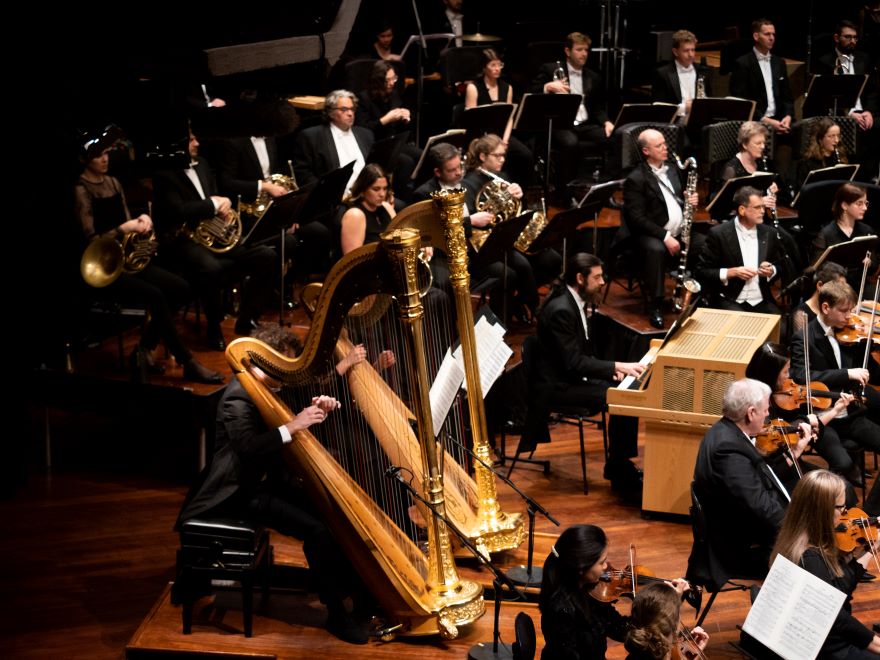Principal Conductor Asher Fisch’s deft leadership guides the West Australian Symphony Orchestra (and the audience) through colossal and unpredictable soundscapes, writes Claire Coleman.
On a grand scale
29 August 2021
- Reading time • 6 minutesMusic
More like this
- Rewriting tradition with skill and charm
- Close encounter stirs the soul
- The great unknown
‘Asher Fisch conducts The Planets‘, West Australian Symphony Orchestra ·
Perth Concert Hall, 27 August 2021 ·
It’s always a treat to attend a concert that is both thoughtfully programmed and well executed. The West Australian Symphony Orchestra’s concert “Asher Fisch conducts The Planets“ more than satisfies on both metrics.
The Overture from Wagner’s The Flying Dutchman put WASO’s superb technical control on display from the concert’s opening. Veering dramatically between lithely whispered pastoral sonics and densely packed brassy waves with busy strings, every dynamic shift is tastefully executed.
Fisch cuts an energetic and striking figure on the podium. The musical directions he provides the orchestra are both economical and expressive, melding clarity and characterisation in a manner that encourages flamboyant delivery without allowing any technical compromise. It’s exhilarating to watch these dual foci come together in works of such epic scale as tonight’s Wagner, Berg and Holst.

Before launching into Berg’s Three Pieces for Orchestra, Fisch gifts the audience with brief but rich listening notes. As a student of Schoenberg, the progenitor of twelve-tone music, Berg’s music has a reputation for a degree of inscrutability. Situated between tonight’s other two popular and accessible works, Fisch hints that Three Pieces has the potential to feel like broccoli the audience is obliged to consume before enjoying The Planets for dessert.
In fact both Berg and Holst, writing during WWI, exploded musical norms of the time, but while the ongoing popularity of Holst’s suite makes it harder for modern listeners to hear, Berg’s harmonic language and disruptive structures remain disconcerting. If The Planets explores the mysteries of the universe from the observatory, Fisch explains, Three Pieces examines the mysteries of the human soul from the psychologist’s sofa.
The Berg begins with glossy gongs and skittering unpitched percussion. The unsettled nature of the “Präludium” persists in the scherzo-like “Reigen”, where waltz themes emerge and dissipate before they are fully established, interrupted by the rat-a-tat drumming of bows by WASO’s strings playing col legno, and bell-raised growls from woodwind and brass.
The “Marsch” finale is restrained at first, featuring ostinato patterns that don’t quite repeat often enough to earn that term. Berg builds palpable excitement, but it repeatedly evaporates anticlimactically. WASO’s execution of such compositional instability is superb and the audience is effusive in its applause after this thorny listen.

A massive orchestra is required for both this and Holst’s Planets, and without the support of students from the Australian National Academy of Music (in lockdown in Victoria) casual players were recruited to join the WASO regulars.
In The Planets Alessandro Pittorino gives the Concert Hall’s pipe organ a rare outing, with some noteworthy flourishes toward the end of, “Mars”. Nimble tempo shifts are well executed in “Venus”, with nearly every section of the orchestra taking a lyrical turn. Holst’s required two harps are supplied by Yi-Yun Loei and William Nicols, whose laser-sharp precision is exposed in “Mercury”, where Adam Pinto also twinkles on celeste.
WASO’s technical control is again on display in what is likely The Planets’ best known movement, “Jupiter”. Fisch subverts complacent listening by pushing the tempo slightly, yet still a few audience members subtly hum along to the main hymn theme “Thaxted” (otherwise known as “World In Union” from the Rugby World Cup).
The last three movements may be the work’s least familiar, but it was these that best displayed the boundary breaking Fisch had hinted at. Holst’s instrumentation may be extra, but it is never excessive, as shown by the harps in “Saturn”, appearing first alongside Alex Timcke’s sensitive timpani and then in gorgeous concert with the double basses. The percussion is raucous in “Uranus”, joining the low brass in facilitating a particularly clamorous crest that drops away immediately to almost nothing. “Neptune”’s dramatic close with sopranos and altos from WASO chorus singing invisibly from the wings is not spoiled by some minor intonation issues.
The thoughtful programming by WASO’s artistic team here enhanced each of the three works, and could be fully appreciated thanks to the guidance provided by Fisch. More please!
WASO’s next performance is the “Southern Symphony Tour”, 2 – 5 September 2021.
Pictured top: Asher Fisch conducts the West Australian Symphony Orchestra. Photo: Linda Dunjey
Like what you're reading? Support Seesaw.






